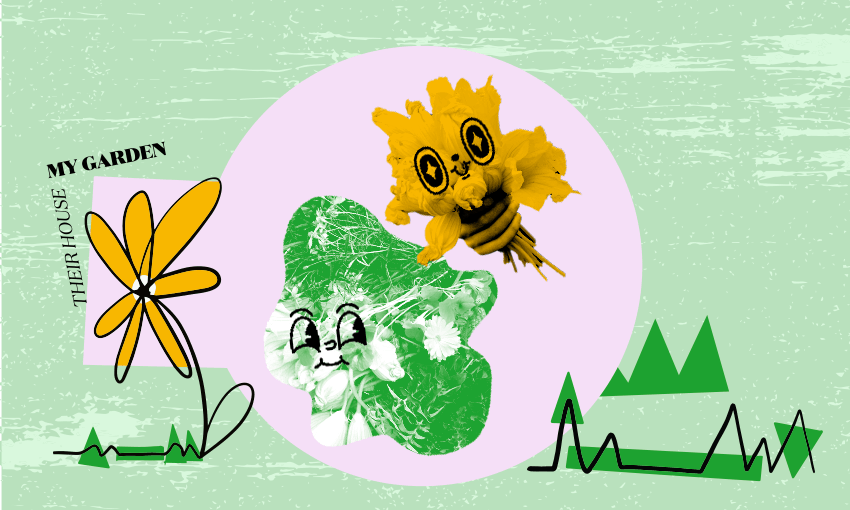This week on Their house, my garden, we meet a very different sort of gardener.
Some people might say that the best thing about artists is that they make the world more beautiful and you can put their work on your wall to make your home look cool. I think the best thing about artists is that they’re weird and they approach life and stuff in ways that the rest of us might never consider.
From behind a tangle of vines, Adam Ben-Dror greets me in a grey knit jumper speckled with patches of careful darning. He’s an artist, designer and inventor based in Tāmaki Makaurau, and part of Compost Collective. We’re at Growing Point, a community garden in Point Chevalier, to collect ingredients for a collaborative artwork slash dinner.
Ben-Dror has foraged other ingredients, like elderflower from the side of State Highway 1, and beets and potatoes from an abandoned back corner of a community garden in Ranui. It’s an area in the garden that has been neglected since Covid lockdowns, and Ben-Dror says that he can still see patterns of planting, but it’s almost entirely overrun with wild growth now. “It’s my favourite place to go,” he says, “to see what the plants are actually doing.”
His gardening style is inspired by a concept called “do-nothing farming” which he found in the book The One-Straw Revolution by Japanese microbiologist turned farmer Masanobu Fukuoka. In the book, Fukuoka traces how he allowed systems on his family farm to work with, rather than against, nature. Over 30 years he developed a “do-nothing” method, refusing to use chemical fertilisers, pesticides, weeding or fancy new machinery. Instead, “I was aiming at a pleasant, natural way of farming which results in making the work easier instead of harder,” Fukuoka wrote.
“The plants I love at the moment,” says Ben-Dror, “are the ones that grow themselves. If you want to be in my garden, then good. If not, that’s OK.” At the moment the plants that do want to be in his garden are fennel, Japanese chrysanthemum, pumpkin, celery, sorrel, mint and calendula. “I don’t have gourmet tomatoes, but I’ve got so much fennel,” he laughs, “and I love calendula. Once that’s in your garden, it’ll always be there – it self-seeds. The petals are edible in a salad or you can put the whole flower in tea. It’s so luxurious.”
He plants by simply throwing seeds everywhere and then seeing what happens. Sometimes he will water if it hasn’t rained in a while. He also keeps an eye out when he’s out and about and has formed a map of plants he may return to forage later – perhaps a bunch of elderflower, kawakawa, or a bay tree. Meanwhile I’ve been planting my vegetables in a defined box, separate from the rest of my garden, which is in turn separate from the rest of my neighbourhood, like a complete egg.
The collaborators for the dinner, Ben-Dror, curator Felixe Laing, and artists Chris Berthelsen and Rebecca Swan want to create an abundant, local luxury on the table. Ben-Dror’s garden wasn’t quite big enough to provide for the number of guests so he reached out to community gardens and friends with gardens to source everything. Here at Growing Point, what we’re collecting isn’t exactly the produce they are growing, it’s the marginal plants in the garden.
The big tangled vine is a Shark fin melon plant. It grows fruit which look like melons, but are more like marrows, which none of the volunteers are too keen on eating and that Laing, the head chef, “couldn’t get excited about”. Though the fruit seems widely abhorred, it’s often grown to enrich the soil and provide mulch. Its blossoms, almost identical to zucchini blossoms, caught Laing’s eye, and she decided to stuff and fry them. We snip 20 of them. Beside the vine there’s a patch of flowering clover, which is grown on the edges of paths to fix nitrogen into the soil, but whose purple flowers can be eaten in a salad. “I don’t know its medical qualities,” says Ben-Dror, “but it’s delicious.”
Then we collect the sweet smelling leaves and flowers of Mexican marigold, pineapple sage and borage, whose destiny, I think, is to be made into teas at the end of the meal. When the blossoms, leaves and flowers come together they are the prettiest bunch I’ve ever seen.
Not everyone has been enthused by Ben-Dror’s gardening. His first do-nothing garden was planted at his parents house in Petone about five years ago. Recently, his brother has taken over, and gotten rid of everything, except the Comfrey. “I know he can never get rid of it – the more you try to get rid of it the more it will pop up,” says Ben-Dror, laughing. “I don’t think he thinks anything I was growing was food.”
Top tip: Throw seeds everywhere and see what happens.
Task of the week: Eat something you thought was a weed.



